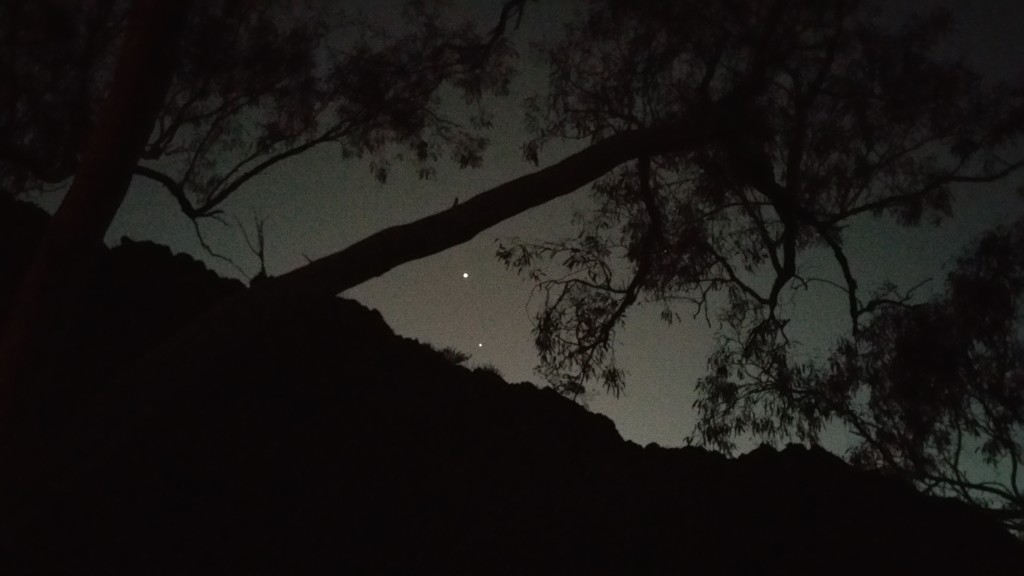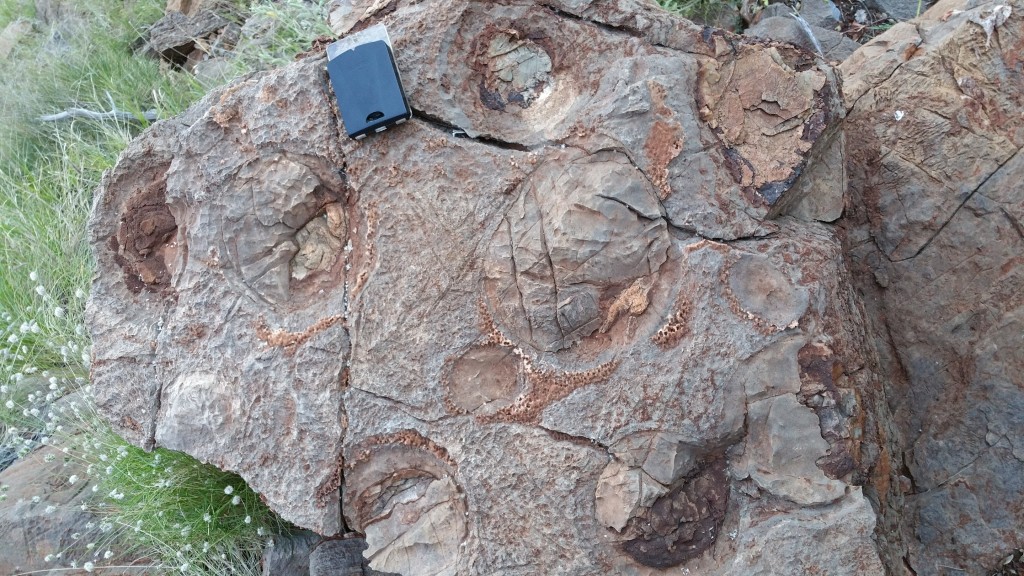Martin Van Kranendonk is a Professor of Geology at the University of New South Wales. His research focuses on the early Earth and the evolution of the planetary system through time. He is particularly interested in crust formation processes in the Archean and the interplay and feedback(s) between planetary dynamics and changes in the atmosphere/hydrosphere and biosphere.
An isolated valley west of Paraburdoo in the southern Hamersley Ranges of Western Australia.
Over the past couple of nights we’ve been watching Venus and Jupiter trade places in the sky as we lie in our swags in the evening admiring the clear, bright night sky. This night, Jupiter has caught up and passed Venus and is below its nearer, brighter, but in real life smaller sister of our solar system. The night sky is one of the true joys of doing research in this area. That and the complete quiet and peace – no thrumming hum of traffic that you get, even on quiet days, in big cities.
But the big attraction here is what we have come to study. A thick ridge of exceptionally well preserved dolomite with wildly abundant stromatolites and thin black cherts in which we have microfossils. Now these types of rocks have been found before and are an important record of life’s evolution of our planet from 3.5 billion years ago to the Phanerozoic.
But, what is special about THIS ridge is its age and degree of preservation. The age is 2.4 billion years old, which is important because it is right at the period when free oxygen started to rise in Earth’s atmosphere and records life’s adaptation to the most fundamental revolution in Earth history. AND, it turns out that this is THE ONLY DIRECT record of life at this period. Whereas there are other successions around the world, they are either not that well preserved, OR they do not have stromatolitic dolomites and black cherts, only deep water deposits or continental deposits that do not contain a very full or useful record of life.
The other aspect is that the preservation of the rocks are stunning. There is no real evidence of metamorphism in the dolomites – much of the sediment between stromatolites is still micritic. And the black cherts are extremely fine grained and still look glassy. Most cherts worldwide are recrystallised to some, but these ones are shiny and incredibly vitreous. Most importantly, we have found that they contain microfossils. And not your normal everyday shallow water microfossils, filamentous cyanobacteria. No, the cherts come from a deep water setting and are full of very long, filamentous microfossils that we interpret are a sulfuretum, a community of micro-organisms that cycle sulphur without the need for sunlight. More excitingly, we think we have found eukaryote microfossils, but that is the subject of a current PhD study and we just finished collecting a whole range of new samples for more detailed analysis.
Anyway, that’s all good. The stromatolites ridge we are studying is 350 m thick and full of stromatolite forms that we’ve been studying to get an idea of how life adapted to the change from an anoxic to an oxygenated atmosphere. We see a lot of forms that are NOT present in older rocks and represent the first appearance in the geological record. We’re interested in how those changes in form may reflect changes in microbe community structure and/or evolutionary development as an adaptation to the changing composition of the atmosphere.
I’ve been going to this ridge now for 5 years and the time spent there is sort of like a relationship: the more time you spend on getting to know the ridge, the more you get back. You just see more when you spend time on it. And that leads (finally) to the story for this post.
There’s one access route up the side of the ridge that requires stepping over a boulder-size rock that is part of the bedded dolomites with an exposed bedding plane. So, we’ve stepped over this rock a hundred times to get up to some amazing stromatolites we call the “Christmas Tree” stromatolites because they have unique, sideways branching columns halfway up their full height (1.7 m high). Anyway, on the 100 and first time, we actually “see” the bedding plane surface of this rock we have to step over; and it is extraordinary. It is actually the bedding surface immediately at the base of the “Christmas Tree” stromatolites and consists of a series of perfectly circular depressions, randomly distributed across the surface and up to 15 cm in diametre. The depressions have an outer ring and an inner, lower ring and then a perfectly circular bowl-shaped inner depression. The depression are filled with a thin, lower, lens of black chert and an overlying, thicker, lens of pale grey chert. THE REST of the depressions are filled by medium-grained carbonate sandstone that fills and actually overfills the depressions, making small mounds that stick up over the bedding plane in which the depressions are developed.
So, how the $)^&% did these things form? We first thought it was aliens throwing acid rain hailballs that melted, but quickly dismissed that. Then I thought it could be a sheet of evaporative silica that shrank and coalesced into circular lenses with a low pH that ate down into the underlying carbonate. But that seemed a stretch and we didn’t know how silica looked when it shrank, but there was no shrinkage textures of any description. Then we noticed on the cross-sectional side of the boulder that there were several, quite wide dewatering/degassing structures. One of my students suggested the circular depressions might be sinkholes over water/gas escape structures, which sounds more reasonable. The cool thing is the black chert. Just imagine of these contain microfossils!! That would be SO COOL!! What a find. The most unlikely of environments to find a signature of life, and so unlikely that this one bedding plane would be exposed in ONE boulder, and then that we wold walk over it so many times before “seeing” it.
That was our last day in the field for this season, and what a way to end it. I just love it when you find something you not only don’t expect but didn’t even know existed. And to scratch your brain to figure it out, or at least develop a testable hypothesis. I am a lucky guy to work in such a fantastic area, with a group of bright students who teach me, but are there to share the experience with me….
![]() This work is licensed under a Creative Commons Attribution-NonCommercial-ShareAlike 4.0 International License.
This work is licensed under a Creative Commons Attribution-NonCommercial-ShareAlike 4.0 International License.


